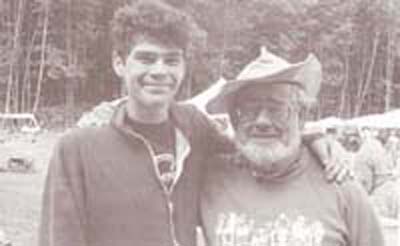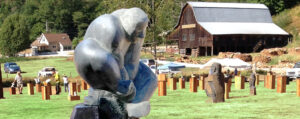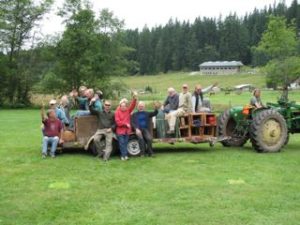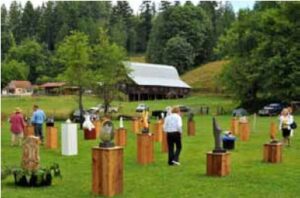Home » NWSSA Events » Shows » Past Shows » Stone Dust: Camp Brotherhood Musings – Sept/Oct 1999
This valley and environs, graced by evergreen mountains, houses, a gathering of people with artistic souls. We work under tents-no two are alike-in the valley itself where we pick diverse stones from a designated rock pile and purchase them on the spot.
Some sleep in tents in the valley, not too far from outhouses; others sleep in lodges on surrounding hills. We all share meals and laughter at the main lodge or under a roof in the valley.

Some days, in the mist, clouds and fog hang over the mountains. Other days are sunny, an inviting contrast. Only on clear days do we swim in the pool after work is done.
During day, profound energy is expended in the valley; this is a workshop for stone sculptors from far and near, plying their craft with hand tools and power tools. I can sit on the deck of our lodge on a hill overlooking the colorful tent village and hear chinks of a hammer and chisel and the drill of a diamond grinder, plugged into the generator, located mid-field. Stones more easily penetrated are soapstone, limestone, and alabaster. Marble, serpentine, and granite are harder. Earplugs keep out the noise, gloves protect the hands, masks keep the lungs free of stone dust, and goggles prevent chips from injuring the eyes.
There are people from the wide world: The small, wiry, middle-age man from Peru is sculpting, out of alabaster, a mythical madonna holding two babies in her arms; however her feet are those of an eagle. The engaging, sensitive young man from Iraq who had rebelled against Saddam Hussein while in his early twenties, only to find himself in a refugee camp for several years, is sculpting a graceful woman’s naked figure out of Colorado Yule marble. The fifty -one year-old serious man from Japan is sculpting an exquisite, simple egg out of serpentine. The attractive blond woman from Germany, originally from Norway, is sculpting a huge, rounded vessel out of granite. The friendly man, who teaches art in high schools in Toronto, Canada, originally from Germany, is sculpting a fetching, stylized bear out of white alabaster. And the bearded man from the United States is sculpting an energetic, abstract, granite piece. He has been sculpting for thirtyfive years, since his last year at Stanford when he was studying biology.
Communication is not a problem; our first language is stone. “Not too much taking is a beauty,” says the one from Japan.
Also in the valley is a yellow farmhouse and animals. From our lodge to the work site, which is a five-minute walk, I amble across the rolling green and violet pasture to where horses and a burro graze. One afternoon the burro, his nose to my rump, gently nudged me along my way. Across the dirt road in an adjacent field, laced by pinkish foxglove, are grazing cows and sheep, somnolent pigs and a goose family playing in a pool of muddy water.
We have had a few workshops in the bam, which must seldom be visited by humankind; indigenous birds set up a constant, insolent screech of indignation when we are there. One of these three hour morning sessions was a figurative drawing class which afforded us the opportunity to draw a handsome, nude, male model. The atmosphere was interestingly asexual.
As time draws to a close, finished works of art are exhibited in the village on a grassy spot marked Gallery. I, for one, will have no finished stone to show. I am a novitiate who attempted sculpting my first stone here in this valley-a lovely, white Montana soapstone. Little did I perceive what I was undertaking; this process involves more than simply sculpting a rock. As I experimented with hand tools and different forms, first a shelter/woman, then an abstraction with an opening in the center. I became frustrated. I found it difficult to chip away negative space. I felt, This beautiful stone rests in my hands. There is an emotional link between it and me, and I want to give it life; instead, lfeell have reduced its potenlial for life. But as I heard one sculptor say, “As long as you have a stone, as long as it’s not totalJy reduced to dust, you can still bring it to life.”
One morning before breakfast, some of us walked in silence up a hill to the chapel. I looked for a cross, not that it needed one. And then, after meditating for some time with my eyes closed, I looked beyond the altar through a parabolic window. And there, in all its supernal subtlety. was a cross: in fact, there were many crosses incorporated as cross-like windowpanes, the tallest being the one in the center; the others, gradations to the right and left. There was room for Jesus and the other two, as well as for us. As we left the chapel, a fann rooster crowed.
At the end of a workshop, the leader asked what fonns people worked with, if people would like to say. It was difficult to articulate, but one by one. sculptors spoke up. And their utterances were revelatory:
The one from Japan related that his fonns come from the question of where people go when they die? Orion and the Milky Way influence his forms as well. He keeps images for a long time; it’s a matter of feeling rather than seeing. For him, harmony with nature is important. He works with oblong-like torsos. He contrasts a flat plane with a natural plane. His forms are self-contained and calm.
One woman, an American, who has been sculpting for twenty-five years, said, “I seek fOlms that are calm, peaceful. and sensual. I especially like to work with Italian translucents. Because I need a hands-on approach, I work primarily with hand tools. I also need a quiet environment. For as long as I have sculpted, I have had a brittle bone disease.”
Especially revealing to me was my husband’s response. He said, “My fonns contain three-dimensional double and triple complex curves. Fonns are also taken from fundamental Haida indian design. And the Art Nouveau style influences my images. I look for line or fonn in everything.” For the fIrst time I understand his art. A breakthrough.
This partnership he and I have found here is a bit astonishing. Something to build on. The stone is in our hands, and it has not yet been reduced to a rubble of dust.







We need some kind of descriptive text here.